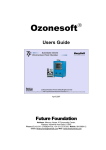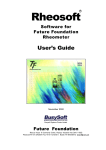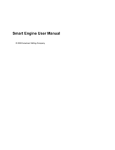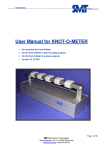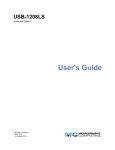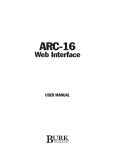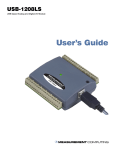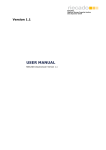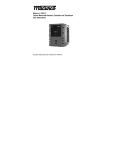Download Mooney Viscometer User Guide
Transcript
ViscoSoft Users Guide April 2007 Busysoft We make software that works as per you Future Foundation Address: Mercury House 16 Community Center, Wazirpur Industrial Area Delhi 110052 Phone:(O)+91-011-27374402 Fax: +91-011-27373011 Mobile: 9810068112 email: [email protected] Web: www.ffinstruments.com Viscosoft User Manual Copyright © 2001 Busysoft Systems Pvt. Ltd. All rights reserved. No part of this publication may be reproduced, in any form or by any means, without prior written permission from Busysoft Systems Pvt. Ltd. Busysoft, Rheosoft, Viscosoft are registered trademarks, and is used by Busysoft Systems Pvt. Ltd. Microsoft, Windows, Windows NT, Windows 2000, Windows XP and their respective logos are registered trademarks of Microsoft Corporation in the United States and other countries. All other product names mentioned in this guide may be trademarks or registered trademarks of their respective companies and are hereby acknowledged. Disclaimer Busysoft makes no representations or warranties with respect to the contents of this publication and specifically disclaims any implied warranties of merchantability or fitness for any particular purpose. Further, Busysoft reserves the right to revise this publication without notice. Warranty The software and related documentation are provided “AS IS” and without warranty of any kind. Busysoft expressly disclaims all warranties, express or implied, including, but not limited to, the implied warranties of merchantability and fitness for a particular purpose. Busysoft does not warrant that the functions contained in the software will meet your requirements, or that the operation of the software will be uninterrupted or error-free, or that defects in the software will be corrected. Furthermore, Busysoft does not warrant or make any representations regarding the use or the results of the use of the software or related documentation in terms of their correctness, accuracy, reliability, or otherwise. No oral or written information or advice given by Busysoft or a Busysoft authorized representative shall create a warranty or in any way increase the scope of this warranty. Should the software prove defective, you (and not Busysoft or a Busysoft authorized representative) assume the entire cost of all necessary servicing, repair, or correction. Under no circumstances, including negligence, shall Busysoft be liable for any incidental, special, or consequential damages that result from the use or inability to use the software or related documentation, even if Busysoft or a Busysoft authorized representative has been advised of the possibility of such damages. In no event shall Busysoft total liability to you for all damages, losses, and causes of action (whether in contract, tort (including negligence) or otherwise) exceed the amount paid by you for the Software. Quick guide Installation Install Mooney Viscometer Machine Install Computer Install a printer Install and start software Install Viscosoft software Install ADC connecting device and link it with Viscometer Start software Set parameters with Setup option Change company information Software implementation Add required compounds from Compound details option Daily running Run testing on the above compounds from Specimen Test Details Print test report Print statistical analysis reports Add more compounds if required and run tests Periodic (Week, Month, Year, Period) Print advance statistical analysis Take backup/maintenance When ever required Run auto calibration Starting Viscosoft On double clicking Mooney Viscosoft icon on the desktop screen following windows appears. Note: When starting the software for the first time a screen may appear showing that a backup/compact repair of database is due. Click on OK or cancel in all cases. Please read section on this in Setup option chapter. This is main login screen of Viscosoft. All authorized user are allotted a user id and a password. Type the user ID and password as allocated by the Supervisor of the software. (Manager who allots the software security options to each user.) Type the following information in the windows. User ID Password ID of the user who is going to work on the software Type the required password. If you type a wrong ID or password the software will not allow you to enter into the software functions. All the security function will be set as per your security level set by the supervisor. Main Menu This is the main menu of ViscoSoft software. The options in the main menu of the software are. Specimen Test Details: This is the main option. All Mooney Viscometer tests can be conducted using this option. This option stores specimen details along with graphs and result analysis. Compound Details: This option stores list of all the stocks. The details of stock specimen, which needs to tested are stored in this option. Data Analysis: This option helps in statistical data analysis of the specimens. Auto Calibration: This option contains calibration standard specifications of your Mooney Viscometer. User can recalibrate equipment if required using this option. Data Maintenance: This option is for taking data backup. Setup: This option is for master setup, Graph setup, Printer and reporting setup, security setup and other master information setup. These parameters are to set only once. Tools: This option is for working with Notepad, Calculator and Calendar. Exit Quit from program. Specimen Test details On clicking specimen test details following screen appears. This is list of the entire tested specimen in order of Test no. The cursor is placed on the last tested specimen. Specimen list details and options The screen has three main options Period: This option helps in choosing period of conducted tests for showing details. Various buttons in the option are Previous date: The option shows list of specimen for previous date. Next Date: The option shows list of specimen for Next date For a Date: Shows list of records for a particular date. The screen shows calendar to Choose the date. Select the required date from the calendar and click OK. Select All: The option shows list of records of all dates. For a period: The option Shows list of records for a particular period. The screen shows starting and ending date. Select or type the required period and click OK Advance Search: This option helps in searching the conducted tests details on various methods. The details in this option are Search on: You can search the details on the basis of Test No., Session No., Batch Id, Compound Name, Operator and Test Date. Search What: Type the required details to be searched. The required search will depend upon above search on parameter. For example to search details of all the specimen tested for a compound name, you should select Compound name as above and then type the name of compound to be searched. You can also type few starting or ending, or any middle characters in the text for the information to be searched. Search Criteria: User can search matching details depending upon the typed value. The details that can be searched are (1) String- the records, which contain typed value in string. Following example shows Search on: Compound name Search what: +4 Search Criteria: String (2) Like: Records, which starts with typed value in string. Following example shows Search on: Compound Name Search what: TEST Search Criteria: Like (3) Match- the records, which matches typed value in string. Following example shows Search on: Operator Search what: KESHAV Search Criteria: Match (4) All- All the records irrespective of any criteria Following example shows Search on: Test No. Search what: _____ Search Criteria: All List of specimen (records): This screen is the list of all tested specimen. The list contains following columns. Test No. This is a running serial number of the tested specimen. Session No. This is Session number of the tested specimen. See the Specimen details as explained below. Batch ID Allotted batch ID. Compound Name Name of the compound tested Operator Name of the operator Test Date Date of testing Rotor Size Rotor Size Temp. Temperature of the test Time Time duration of the test P/F (P) ass/(F) ail result of the test The options available under this option are Add Add a new specimen details for testing Modify Modify the specimen details for testing Delete Delete the current specimen. You will be asked to reconfirm deletion. Select Select and shows the current specimen details and results Previous Show previous specimen Next Show next specimen Jump Go to a particular specimen number. The screen will show the details of the required specimen. Print Print or preview specimen result details of the current specimen. Following screen appears: The parameters in the above screen are Print Graph in Report: Tick it as þ to show graph in report. Print On (Printer): Select the printer on which you want to print the report. The options in the screen are Print To print report on the selected printer. Preview Show preview of the report before printing. Adding Specimen Click on Add option as shown in specimen list screen above. Following screen appears. Press ‘Yes’ in case if you want to add the specimen in the same session as previous test. Press ‘No’ to allot new session number. Following are the various parameters that are required to be filled. Test Details Test Number This is the test number of the specimen. It is allotted automatically. In the above screen this number is 17. You cannot change this number. Session No. This is session number of the specimen. It is allotted automatically. In the above screen this number is 8. You cannot change this number. A session is a number allotted to number of tests done in a group. It helps in statistical analysis, probability studies. Compound name Select the compound name to be tested. A list of compound is shown for selection. Press Enter to select the compound. Batch ID This is the batch id of the specimen being tested. Type the required ID and press Enter. Operator This is name of the operator conducting the test. Type the name and press Enter. Test Date This is the date of testing in dd/mm/yyyy (day/month/year) format. The box shows current date automatically. You can change the date by typing or by clicking down arrow button shown next to date. A calendar will appear for selecting the date. After selecting the date press [Enter] to continue. On pressing [Enter] the focus is placed on [Save]. On pressing [Save] button the details are saved and following screen is shown. The other details shown are: Compound details: Last revised date Preheat Time (Min.) Stock Mix Test Temperature Rotor Size Test Duration (Min.) Test Type Mooney range Date of last updating of compound details. Preheat time required for testing Type of stock mix. Temperature at which test is conducted. This should be same as set on the temperature controller. Size of the rotor used Duration of test in minutes Type of test namely Viscosity test or Scorch Test Range of Mooney value Testing Specimen Loading specimen and testing Click on Start Test to test the specimen. Following screen appears. Prepare and load the specimen and press OK. The Mooney Viscometer Machine will start functioning and a graph will appear on the screen. Following details are shown on the graph screen. The graphs shows: 1. 2. 3. 4. The time period in Minutes on X-AXIS divided into 12 parts Mooney Values on Y-AXIS divided into 10 parts. Temperature on Y-AXIS divided into 3 parts Current point at the bottom of screen showing the current time, Mooney value, Lower and upper Temperature. After the completion of test a screen showing that test is completed appears. If you want to add another test click on ‘Yes’. Following screen appears. Type the Batch ID and click on Start Testing to test next sample. On clicking this option the process of testing starts again for this batch. Click on Exit Testing if you do not want to run the test. The screen shows the graph of the tested specimen. The graphs has following option buttons Ê x Ì • |t t u u| U Print report on printer Shows Stress relaxation test result. Add new specimen for testing in the same session Shows all the specimen graphs in the session. Shows First specimen graph in the session Shows previous specimen graph in the session Shows previous specimen graph in the session Shows last specimen graph in the session Closes this screen and goes back to test specimen details screen. Print report on printer On clicking this option following screen appears The parameters in the above screen are Print On (Printer): Select the printer on which you want to print the report. The options in the screen are Print On clicking print option button the report is printed on selected printer. Preview Show preview of the report before printing. Printing Stress Relaxation Report Same option appears for printing stress relaxation report. Showing all the specimen in same session Show all the specimen graphs in a session. Quit from testing and go back On clicking this U button the specimen details screen appears showing the test results. Test Results After conducting the test the results shown are: Test Results: (Viscosity test) as shown above These details are shown as the per the test type: In case of Viscosity test following details are shown. Test Status This is the status of test as Tested/ Not tested. Pass/Fail The specimen results are compared with a set of pass/fail criteria set under compound details. The specimen is termed accordingly. The compound details section described in the following sections shows these parameters. Stress Relaxation This is stress relaxation parameter set under compound details. Results (1) ML (1 + 1) 100 (2) ML (1 + 2) 100 (3) ML (1 + 3) 100 Mooney value at (Preheat time + 1 minute) after ML at 100 Degree Celsius Mooney value at (Preheat time + 2 minute) after ML at 100 Degree Celsius Mooney value at (Preheat time + 3 minute) after ML at 100 Degree Celsius The above three values are as per compound details. The required result values are set in compound details. Initial Viscosity Min. Viscosity Stop Time End Temp This is initial Mooney Viscosity value. This is minimum Mooney Viscosity. Stop time of the test Temperature at the end of testing. Test Results: (Scorch test) as shown below This screen shows the Scorch graph Scorch test specimen shows following details. Test Status Pass/Fail This is the status of test as Tested/ Not tested. The specimen results are compared with a set of pass/fail criteria set under compound details. The specimen is termed accordingly. The compound details section described in the following sections shows these parameters. Stress Relaxation Not applicable Results (1) T - 5 Time at 5 Mooney above Min Viscosity (2) T-35 Time at 35 Mooney above Min Viscosity (3) ML (1 + 4) 125 Mooney value at (Preheat time + 4 minute) after ML at 125 Degree Celsius T(35) – T(5) Difference between T (35) – T (5). The values 35 and 5 values should be set in the compound details. Compound details On clicking Compound details following screen appears. This is list of the entire compounds for testing in order of compound no. The cursor is placed on the last compound. Compound list details and options Advance Search: This option helps in searching the compound details on various methods. The details in this option are Search on: You can search the details on the basis of Compound No., Compound name, Stock Mix type, Test type, Rotor Size, Test Temperature, Mooney Range, Test Time and Last revised date. Select the search criteria for listing the compound details. Search What: Type the required details to be searched. The required search will depend upon above search on parameter. For example to search details of all the compound for a compound name, you should select Compound name as above and then type the name of compound to be searched. You can also type few starting or ending, or any middle characters in the text for the information to be searched. Search Criteria: User can search matching details depending upon the typed value. The details that can be searched are (1) String- the records, which contain typed value in string. Following example shows Search on: Compound name Search what: SCORCH Search Criteria: String (2) Like: Records, which starts with typed value in string. Following example shows Search on: Compound Name Search what: TEST Search Criteria: Like (3) Match- the records, which matches typed value in string. Following example shows Search on: Test Temperature Search what: 100 Search Criteria: Match (4) All- All the records irrespective of any criteria Following example shows Search on: Compound No. Search what: _____ Search Criteria: All List of Compounds (records): This screen is the list of all compounds. The list contains following columns. Compound No. Name Stock Mix Test Type Rotor Size Preheat time Range Revised date Temp. Time This is a running serial number of the compounds This is the name of the compound. Type of mix as Milled or Un milled Type of test as Viscosity test or Scorch test. Rotor Size Time of preheat in minutes. Largest Mooney range required. last date of modifying the details Temperature of the testing the compound Time duration of the testing the compound The options available under this option are Add Add a new compound details for testing Modify Modify the compound details for testing Delete Delete the current compound. You will be asked to reconfirm deletion. Select Select and shows the current compound details and results Previous Show previous compound Next Show next compound Jump Go to a particular compound number. The screen will show the details of the required compound. Print Print or preview compound details of the current compound. Following screen appears: The parameters in the above screen are Print On (Printer): Select the printer on which you want to print the report. The options in the screen are Print To print report on the selected printer. Preview Show preview of the report before printing. Adding Compound Click on Add option as shown in compound list screen above. Following screen appears. Following are the various parameters that are required to be filled. Compound details Compound Number Compound name Last revised date Test Type Rotor Size Stock Mix Test Temperature Mooney range Test Duration (Min.) Preheat Time (Min.) This is the compound number of the compound. It is allotted automatically. In the above screen this number is 5. You cannot change this number. This is name of the compound. Date of last updating of compound details. Select the type of test namely Viscosity test or Scorch Test Select the size of the rotor used Small/Large Select the type of stock mix as Milled/Un Milled Select temperature at which this compound is tested. This should be set on the temperature controller while testing. Select highest expected Mooney value for the compound. Select duration of test in minutes. Type preheat time required for testing. The preheat time should not be 0 for Viscosity test. Readings required (Viscosity Test) Type the readings required for a Viscosity test. Four values are allowed for Mooney value at (Preheat time + X minute) after ML at 100 Degree Celsius. (1) ML (1+A) 100 (2) ML (1+B) 100 (3) ML (1+C) 100 (4) ML (1+D) 100 Mooney value at (Preheat time + A minute) after ML at 100 Degree Celsius Mooney value at (Preheat time + B minute) after ML at 100 Degree Celsius Mooney value at (Preheat time + C minute) after ML at 100 Degree Celsius Mooney value at (Preheat time + D minute) after ML at 100 Degree Celsius The 100 Degree Celsius temperature is as per test temperature chosen above. Quality Control Gates Limits (Viscosity Test) Lower Upper values : Type the Lower and Upper control limits for each of Mooney values. These values can also be set later on. The control limits help in QC and statistical analysis. Gates: Click on Gates as R if you want to use this as control gates while testing specimen. Use for pass/fail: Click on the value as R if you want to use the limit as pass/fail criteria. The tested specimens results are compared with these values and are treated as passed. Stress Relaxation Test: Click on this as R if you want to conduct stress relaxation test. (Only for Viscosity test) Relaxation Time: Type the time for stress relaxation test. (Only if above value is checked true) After typing all the details the screen shows. On pressing [Enter] on the last value the focus is placed on [Save]. On pressing [Save] button the details are saved and following screen is shown. Readings required (Scorch Test) Type the readings required for a scorch test. Four values are allowed for Mooney value. These values are (1) T – X Time at X Mooney above Min Viscosity (2) T – Y Time at Y Mooney above Min Viscosity (3) ML (1+A) 100 Mooney value at (Preheat time + A minute) after ML at 100 Degree Celsius (4) ML (1+B) 100 Mooney value at (Preheat time + B minute) after ML at 100 Degree Celsius Type the required result to be calculated as X, Y, A, B. T(35) – T(5) Difference between T (35) – T (5). The values 35 and 5 values should be set in the compound details. Quality Control Gates Limits (Scorch Test) Type the Lower and Upper control limits for each of Mooney values. These values can also be set later on. The control limits help in QC and statistical analysis. Gates: User for pass/fail: Click on Gates as R if you want to use this as control gates while testing specimen. Click on the value as R is you want to use the limit as pass/fail criteria. The tested specimens results are compared with these values and are treated as passed. After typing all the details the screen shows. On pressing [Enter] on the last value the focus is placed on [Save]. On pressing [Save] button the details are saved and following screen is shown. The details shown also contain Viscosity test details. This is mixed sample where Scorch and Viscosity both tests are conducted. To create purely Scorch test do not fill Viscosity readings. Data Maintenance Cick on Data maintenance option on the main menu. On clicking this option following screen appears The list shows list of all the backups taken earlier. Following options are available Refresh Backup Refresh list of backups taken Click on this option to take backup. After clicking this option backup is taken and following screen appears. Click OK to continue. The list will show the latest backup take above Delete Close Delete the selected backup from the list taken earlier. Quit the option and go back to Main Menu Tools This option is for opening function utilities. The utilities are Temperature conversion A temperature conversion option for converting Degree Celsius into Fahrenheit and vice versa. Notepad Opens a notepad for writing comments. Calculator Opens a calculator for calculations. Calendar Opens a calendar for dates. Diary Opens a diary for noting day-to-day activities. Data Analysis On clicking data analysis option of the main menu following screen appears. The options on this screen are: Statistical Data analysis On clicking this option following screen appears Various parameters on this screen are Testing Date from: Date from which the specimens should be analyzed Testing date to: Date till which specimens should be analyzed. Stock Name: Select stock to be analyzed. Pass-fail criteria: Select all specimens or passed specimens or failed specimens. Selection: Select all or deselect all Printer: Select printer on which report is to be printed. The option buttons are Print Prints following report on selected printer. Preview Shows the report as given below. Close Quit from this option and go back to previous option. Graphical data Analysis On clicking this option following screen appears. Various parameters on this screen are Testing Date from: Date from which the specimens should be analyzed Testing date to: Date till which specimens should be analyzed. Stock Name: Select stock to be analyzed. Pass-fail criteria: Select all specimens or passed specimens or failed specimens. Selection: Select all or deselect all Printer: Select printer on which report is to be printed. Select parameter Select the required parameter for graphical analysis report. The option buttons are Print Prints following report on selected printer. Preview Shows the report as given below. Close Quit from this option and go back to previous option. Statistical Quality control report On clicking this option following screen appears Various parameters on this screen are Testing Date from: Date from which the specimens should be analyzed Testing date to: Date till which specimens should be analyzed. Stock Name: Select stock to be analyzed. Pass-fail criteria: Select all specimens or passed specimens or failed specimens. Selection: Select all or deselect all Printer: Select printer on which report is to be printed. The option buttons are Print Prints following report on selected printer. Preview Shows the report as given below. Close Quit from this option and go back to previous option. Various parameters on this screen are same as described in the previous option. The output report is as shown below. Advance statistical analysis This option is for control charts and capability study. On clicking this option following screen appears Other parameters on capability screen are. Stock Name: Select stock to be analyzed. Analyze parameter: Select the parameter to analyze Testing Date from: Date from which the specimens should be analyzed Testing date to: Date till which specimens should be analyzed. Size of sub group: This is size of sub group for each session or day for capability study. Sub group base: Base of subgroup on the basis of which capability analysis is done. Date wise: All the specimens are selected date wise. Session wise: All the specimens are selected session wise. Pass-fail criteria: Select all specimens or passed specimens or failed specimens. Control chart: Select type of control chart required X-bar and range chart X-bar and sigma chart Data selection criteria: Select the way the data is selected Manual: The data is to selected manually Auto: The data is selected automatically. Auto option: In case if data is to be selected automatically Even: All even number specimens are selected Odd: All odd number specimens are selected Interval: Sample numbers with a specific interval are selected The option buttons are Apply: This button searches all the specimens and applies above parameters. Show: Shows list of selected specimen date wise or session wise Control charts: Shows and prints control charts Capa: Shows and prints capability charts Close Quit from the option. On clicking apply following screen opens. On clicking show following screen appears. You can select or deselect the specimens from the selected specimens. On clicking Control chart following screen appears On Clicking Capa button following screen appears The options on screen are. Print: Close: Print capability analysis and control char Quit from option and go back to main screen. Auto Calibration The calibration option sets calibration Mooney Viscometer. This is list of the entire calibrations for testing in order of calibration no. The cursor is placed on the last calibration done. The system keeps details of all the calibrations done. On clicking this option following screen appears: Calibration list details and options Advance Search: This option helps in searching the calibration details on various methods. The details in this option are Search on: You can search the details on the basis of calibration no., Calibration type, Operator and date. Select the search criteria for listing the calibration details. Search What: Type the required details to be searched. The required search will depend upon above search on parameter. For example to search details of all the calibration for a calibration type, you should select calibration type as above and then type the name of calibration type to be searched. You can also type few starting or ending, or any middle characters in the text for the information to be searched. Search Criteria: User can search matching details depending upon the typed value. The details that can be searched are (1) String- the records, which contain typed value in string. Following example shows Search on: Calibration type Search what: Standard Search Criteria: String (2) Like: Records, which starts with typed value in string. Following example shows Search on: Calibration Type Search what: Standard Search Criteria: Like (3) Match- the records, which matches typed value in string. Following example shows Search on: Operator Search what: KESHAV Search Criteria: Match (4) All- All the records irrespective of any criteria Following example shows Search on: Calibration No. Search what: _____ Search Criteria: All List of calibration (records): This screen is the list of all calibrations. The list contains following columns. Calibration No. Calibration Type Operator Date This is a running serial number of the calibration. This is the name of the calibration type. This is name of the operator performing calibration. This is date of performing calibration. The options available under this option are Add Add a new calibration details for testing Modify Modify the calibration details for testing Delete Delete the current calibration. You will be asked to reconfirm deletion. Select Select and shows the current calibration. Previous Show previous calibration Next Show next calibration Jump Go to a particular calibration number. The screen will show the details of the required calibration. Print Print or preview calibration details of the current calibration. Following screen appears: The parameters in the above screen are Print On (Printer): Select the printer on which you want to print the report. The options in the screen are Print To print report on the selected printer. Preview Show preview of the report before printing. Adding and conducting calibration Click on Add option as shown in calibration list screen above. Following screen appears. Following are the various parameters that are required to be filled. Calibration details Calibration Number Calibration Type Operator Calibration date Motor on/off Standard Value This is the calibration number of the calibration. It is allotted automatically. In the above screen this number is 2. You cannot change this number. This is type of the calibration. Two type of calibration can be conducted namely Standard Rubber and Dead Weight. Name of the operator Date of calibration Turns motor on/off automatically Standard value Result (Dead Weight) Type the Standard value expected for dead weight. After conducting the calibration the software will calculate Offset value and Calibration constant. Result (Standard Rubber) Standard Value (Upper): Type the Lower and Upper values for Mooney values. (Lower) Preheat Time: Test Temperature Type the time for preheat relaxation test. (Only if above value is checked true) Temperature at which the testis conducted. ML Readings required This is test standard for Mooney values. Choose (1) or (2) values to be taken as test standard. After typing all the details the screen shows. On pressing [Enter] on the last value the focus is placed on [Save]. On pressing [Save] button the details are saved and following screen is shown. Calibration (Dead Weight) Click on Calibrate to start the calibration procedure. Following screen is displayed Start the viscometer without any dead weight and press OK. Following screen appears. The screen warns you about changing calibration. Click on OK to continue. After completion of the offset calibration following screen is displayed. The system will now ask to put dead weight to continue with next step of calibration. Hang the dead weight and click on OK to continue. After the calibration is done on dead weight following graph is displayed. On clicking OK to continue the calibration constant and offset constants are calculated. The calibration completes and following screen is shown. The above screen shows the calculated calibration constant and offset value. Following options are available of the screen. Calibrate: Calibration graph: Offset Graph: Print: Run calibration as done above Shows the calibration graph as shown above Shows the offset graph as shown above Prints Calibration graph. On clicking this option following screen is shown The parameters in the above screen are Print On (Printer): Select the printer on which you want to print the report. The options in the screen are Print To print report on the selected printer. Preview Show preview of the report before printing. A report such as shown below is Calibration (Standard Rubber) The Calibration procedure for standard rubber is same as dead weight as explained above. Replace the dead weight with a rubber with known standards. Setup The setup options are main parameter setting option of the ViscoSoft package. These options need to be set only once. On clicking this option following screen appears: The options are Master Setup Sets master parameters Graph Setup Sets graph size and color Printer and Report Heading setup printer and reports parameter Security Setup Setup for security parameters Change Password Allows changing of passwords Data Maintenance Plan Sets automatic periodic data backup and compact plan Company Information Allows changing of company details Company Machine information Shows details of Mooney Machine Standards Machine Machine information Shows details of Mooney usage and machine maintenance plan Master Setup This options helps in setting up main master parameters. On clicking this option following password screen appears. Type the password to continue for the next screen. The Master setup parameters are main parameters and should be changed only by authorized users. These values are to be set only once. On typing the password click on Ok. Following screen appears. The values on this screen are Card Settings: Card Type: The value is set as USB. It is a device, which attaches Mooney Viscometer with PC. Board Number: This is board number of the attached device. Following are the instructions for finding and configuring device number. This is to be done after completing installation procedure of the software as per installation manual. 1. Click on Start > Measurement Computing > InstaCal to launch the Instacal Software A Plug and play Board Detection dialog appears, listing the PMD -1208LS. This dialog only displays when you install the device, or if you reinstall the device. 2. Leave the check box next to the PMD 1208-LS item checked and click OK button to close the dialog. The dialog closes and PMD-1208 LS is added to the PC board List on the instacal main window. 3. Double click on the PMD-1208LS item listed below Universal Serial Bus. The Board Configuration dialog appears. 4. Pull down the No. Of channel list Box and select 8 Single ended as the analog input configuration. 5. You can also check the USB Device connected by clicking on Flash LED. A LED on the USB device will flash three times. LED flashing means that the device is connected properly. Mooney multiple: Temperature Multiple Should always be 100. Do not change this parameter. Should always be 40. Do not change this parameter. Channel selection Upper Temperature Lower Temperature Mooney values: Should always be 2. Should be changed only by FF. Should always be 1. Should be changed only by FF. Should always be 0. Should be changed only by FF. Filter Settings Smoothing factor Division factors Samplings rate A factor for smoothing of test graph. Should be changed only by FF. A factor for showing of test graph. Should be changed only by FF. A factor for testing of specimen. Should be changed only by FF. Calibration Setting Offset Calibration constant This parameter is set by Auto calibration. Should be changed only by FF. This parameter is set by Auto calibration. Should be changed only by FF. Graph Setup This option helps in setting up specimen testing graph parameters. The parameters effect the test graph display on the screen. On clicking this option following screen appears. These values can be changed as requirements. The parameters are divided into two parts namely graph setup, Graph color and line setup. Graph setup It contains following parameters Label of the graph Name of the graph No of graphs this value is always 2 and should not be changed. X-Axis Label This value is X-axis label and should not be changed. Time duration (in Min.) This value is standard value of x-axis size. This value changes as per compound. Tick mark interval Tick mark interval for X-axis and should not be changed. Graph1/Graph 2 Y-Axis label Name of Y-axis label as Temp and Mooney and should not be changed. Size of Y-Axis window It is window size of Temperature and Mooney graphs in 20 and 80 ratio. Tick mark interval Check it as ‘Yes’ if tick marks are required on Y-Axis of the graph. Will the grid be drawn? Check it as ‘Yes’ if you want to draw grid in the graph. Will the frame be drawn? Check it as ‘Yes’ if you want to draw frame in the graph. A presentation of the above parameter is shown below. Graph Color and Line setup This option sets the color and size of the test graph and lines. Windows Background color Text Color X-Axis tick labels Color Graph 1 Tick labels color Graph 2 Tick labels color Graph 1 Background Color Graph 2 Background Color Details grid color Graph 1 Grid color Graph 2 Grid color Lower Temperature Color Upper Temperature Color Background graph Color Graph outline color Show graph parameters Graph outline width Details grid width Graph 1-Grid width Graph 2-Grid width Graph 1-line width Test Graph 2-line width Test Graph 1-line width Report Graph 2-line width Report Graph color Color of the graph window background Color of the text written on the graph X-axis tick mark color Graph 1 Y-axis Tick mark color Graph 2 Y-axis Tick mark color Background color of the Graph 1 Background color of the Graph 2 Background color of details Color of Graph 1 Grid Color of Graph 2 Grid Color of the lower temperature line Color of the Upper temperature Color of the background graph Color of the graph grid Shows graph details Line Width of graph grid Line width of the grid Line width of the Graph 1 grid Line width of the Graph 2 grid Line width of the graph 1 test result Line width of the graph 2-test result Line width of the graph 1 test result report Line width of the graph 2 test result report 15 colors are available for displaying multiple graphs in different colors. Following screen shows the color scheme of the test graph. Printer and report heading setup This options sets installed printer along with print margins for reports. On clicking this option following screen appears The screen contains following details Printer setup Printer Name Left Margin Right Margin Top Margin Bottom Margin Page Size Select the installed printer. Left Margin of the paper Right Margin of the paper Top margin of the paper Bottom Margin of the paper Size of the paper. This paper size should be smaller than paper size set on the printer setup under windows. Show company address in analysis: Tick mark as ‘Yes’ to print company name in report. Show company address in other reports Tick mark as ‘Yes’ to print address in reports. Report heading: Organization Name Select font name, size, type and alignment for printing organization name. Report Heading: Address Name printing Select font name, size, type and alignment for printing organization name. Report Heading Sample Shows the sample details as per the font set above. Click on save to save the changes made. Click on close to drop changes. Security setup This option is for setting security for users. Manager can only open this option. The user id for manager is fixed as MGR and cannot be changed. On clicking this option following screen appears. The screen shows a list of authorized users on the left. The details shown on this screen are User Name User ID Password Name of the authorized user ID of the User User Password The options in this screen are Add Add new user Save Save user options parameters Delete Delete users Show Password Show user passwords Permissions Show user passwords Close Quit this option and go back to previous option. Add new user Click on add to add new user in the above screen. Type various parameters as described below. User Name: Type the user name to be created User ID: Type the ID to be allotted to the user. Password: Type a user password. The user can change this password later on. Select various options, which the user is allowed to work on. Click on save to save the user details. Setting User Permissions Click on permissions button to change user permissions. Following screen appears. Click on Check box as R to allow a user on a particular option. Specimen testing permissions All the other user permission screens are as follows. Compound Details permissions Data Analysis permissions Calibration Permissions Data Maintenance Setup Change password The user can change the used password for better security. This option can be opened by a user only. Following screen appears on clicking this option. The option buttons on this screen are Save: Click this button to save the password. User has to type a new password twice to change the password. Cancel Quit and do not save password.. Data Maintenance Plan This option is used to setup data backup and compact plan. User can set the data backup plan to take automatic backup to avoid data loss due to computer hardware failure. On clicking this option following screen appears. The information on this screen is: Last backup taken on Take backup after Due on Give reminder Date of last backup taken Number of days after which next backup is to be taken Calculation of next due date As soon as the user start the program a message showing that the backup is due and The system will take the automatic backup. Click on Cancel if you do not want to take backup. Click on ‘OK’ to take backup. On completion of backup following screen appears. Last compact Done on Compact data after Due on Give reminder Date of last data compact done (This helps in increasing performance of the software) Number of days after which next compact is to be done Calculation of next due date As soon as the user start the program a message showing that the compact (repair) is due and The system will do the compact (repair) automatically. Click on Cancel if you do not want to compact data. Click on ‘OK’ to start compacting On completion of compact following screen appears. Warning: During compacting and repair or data backup make sure that no power supply failure occurs. Company Information This option sets up user company details and parameters. The company details and parameters are shown and printed on various reports. On clicking this option following screen appears. Type the various parameters and click on Save to save the parameters. This is the user company name, address and other details. These details are printed on the reports. Company Machine Information This option contains information on supplied machine to you. On clicking this option following screen appears. The FF executive on installation fills this information. Do not change this information. Machine Maintenance Information This option contains information on daily machine usage. On clicking this option following screen appears. The FF executive on installation fills this information. Do not change this information The main details for interest to the user are. Last service did on: Next service due after Machine used for Balance duration Display message Date of last servicing of the machine. Period after which next service will be due Period of usage after last servicing done Balance duration period for maintenance The software will display message as soon as the machine is due for maintenance. Specimen reports Note : The reports are for general presentation and may not contain actual data. Busysoft We make software that works as per you Future Foundation Address: Mercury House 16 Community Center, Wazirpur Industrial Area Delhi 110052 Phone:(O)+91-011-27374402 Fax: +91-011-27373011 Mobile: 9810068112 email: [email protected] Web: www.ffinstruments.com









































































